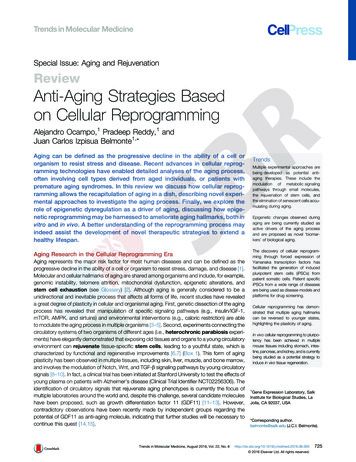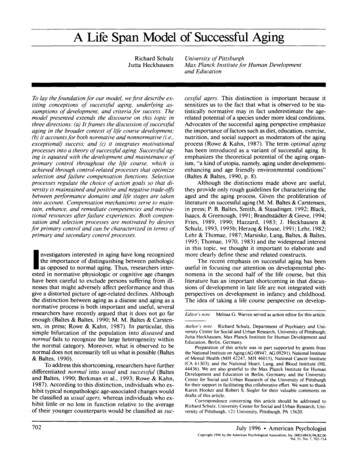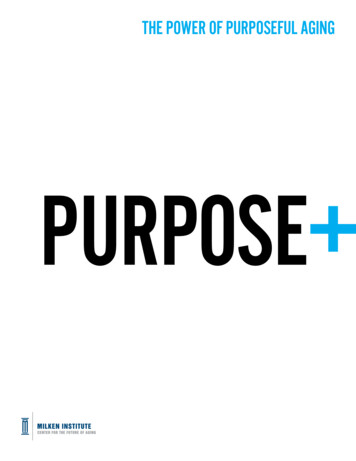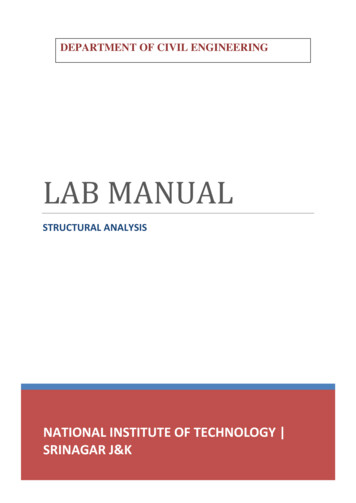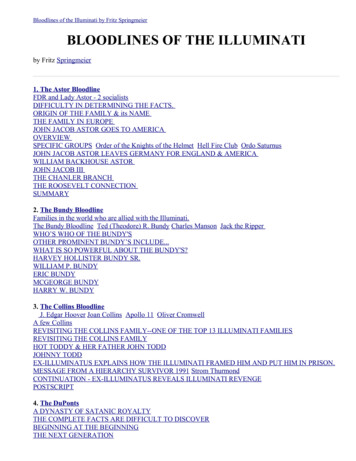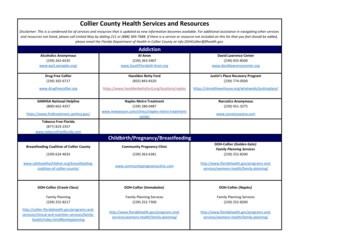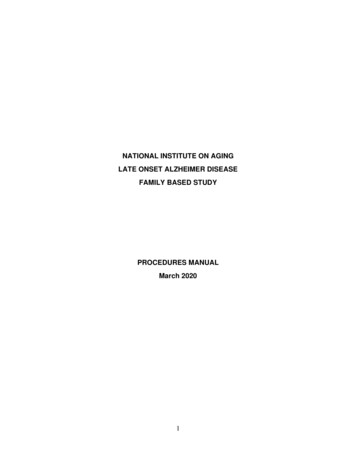
Transcription
NATIONAL INSTITUTE ON AGINGLATE ONSET ALZHEIMER DISEASEFAMILY BASED STUDYPROCEDURES MANUALMarch 20201
TABLE OF CONTENTS1.0 Abbreviations42.0 Purpose43.0 NIALOAD Information53.1 Participating Sites3.2 NIALOAD-FBS Contacts4.0 Family Recruitment and Evaluation64.1 Recruitment Inclusion/Exclusion Criteria4.2 Recruitment Procedures4.3 Clinical Evaluation on New and Follow up Individuals4.4 Minimum Data Set4.5 Globally Unique Identifier (GUID)5.0 Blood Collection85.1 Biospecimen Collection5.2 Biospecimen Collection Kit Contents5.3 Kit Requests5.4 Blood collection and Processing Procedures5.5 Labeling Samples5.6 EDTA (Lavender-Top) Blood Collection Tube (10 ml)5.7 Sodium Heparin (Green-Top) Blood Collection Tube (10 ml) for PBMC5.8 Sample Redraws5.9 Packaging and Shipping Instructions6.0 Data Collection196.1 Data Collection Schedule6.2 Data Cleaning7.0 Brain Autopsy197.1 Deceased family member with previous autopsy2
7.2 Current Participants and Family Members Program Enrollment7.3 Autopsy results7.4 Brain shipment and coordinator contacts8.0 Informed Consent208.1 Consent Procedures9.0 Trainings and Certifications2110.0 Appendices List2210.1 Appendix A: Minimum Data Set10.2 Appendix B: Dementia Questionnaire10.3 Appendix C: Sample Consent Form10.4 Appendix D: Sample Collection Form10.5 Appendix E: Queries/Discrepancies Dictionary10.6 Appendix F: GUID Demographics form10.7 Appendix G: NYBB Fresh Tissue shipping instructions10.8 Appendix H: Sample Form for Frozen and Fixed Brain Tissue3
1.0 RSPBMCPCSAlzheimer’s DiseaseAlzheimer Disease Research CenterComputer assisted TomographyColumbia University Medical CenterDeoxyribonucleic AcidDementia QuestionnaireEthylene Diamine Tetra-acetic AcidFamily Based StudyFrontotemporal DementiaGlobally Unique IdentifierInternational Air Transport AssociationInternal Review BoardLewy Body DementiaLate Onset Alzheimer’s DiseaseMinimum Data SetMagnetic Resonance ImagingSodium Heparin (Green-Top) Blood Collection Tube (10 ml)National Centralized Repository for Alzheimer’s Disease and RelatedDementiasNew York Brain BankNational Institute on AgingNational Institute of Neurological and Communicative Diseases andStroke/Alzheimer’s Disease Related Disorders AssociationIntegrated Neuropsychiatric Inventory questionnaire and the BehaviorRating Scale for dementiaPeripheral Blood Mononuclear CellPersonal, Cultural and Structural analysis2.0 PurposeThe purpose of this manual is to provide NIA LOAD-FBS staff (PIs and study coordinators) at the various study sites withinstructions for family recruitment, sample collection and data submission. The following may be collected at each studyvisit: Medical History Family History Risk factors Dementia Questionnaire (optional- for deceased individuals) Psychometrics NPIQ-CBRS Whole Blood (for DNA extraction) PBMC (for extraction of white blood cells)These procedures are relevant to all study personnel responsible for data and biological specimen collection.4
3.0 NIALOAD-FBS InformationThe National Institute on Aging -Late Onset Alzheimer’s Disease Family Based Study (NIALOAD-FBS) is a U24 proposalin which the main purpose is to develop or maintain unique resources to be shared with the scientific community. Dr.Richard Mayeux at Columbia University, Dr. Tatiana Foroud at Indiana University, and Dr. Alison Goate at the IcahnSchool of Medicine at Mount Sinai, are the co-principal investigators for this study.3.1 Participating SitesSite #Site Name4Columbia University (coordinating center)8Indiana University15Rush University22University of Pittsburgh25University of Texas Southwestern26University of Washington27Washington University61University of Miami62North Carolina A & T63Case Western University10RMayo Clinic RochesterISMMSIcahn School of Medicine at Mount Sinai3.2 NIALOAD- FBS ContactsSite retPericakVanceTatianaForoudGoldie angCarlosCruchagaPI EmailSiteCoordinatorCoordinator EmailJonathan.haines@case.eduRenee LauxRal119@case.edurpm2@columbia.eduDolly ReyesDumeyerKelly s i.eduKatrina Celiskxc672@med.miami.edutforoud@iu.eduKelley Faberkelfaber@iu.edugsbyrd@ncat.eduTakiyah D. Starkstdstarks@ncat.edudbennett@rush.eduCelina PavonCELINA PAVON@rush.eduSweetRA@upmc.eduElise ern.eduAmy Sarah y.wustl.eduJoanne ukjhorner@iu.edualison.goate@mssm.edu5
4.0 Family Recruitment and EvaluationSites will typically recruit individuals from their memory clinics, referrals from other sites, NCRAD or the Alzheimer’sAssociation, as well as previously unidentified members of existing families. We might also use advertisements such asradio, television and newspapers. We will recruit participants who meet the criteria as described in section 4.1.4.1 Recruitment Inclusion/Exclusion CriteriaA. Inclusion criteriaINCLUSION CRITERIONMETHOD OF ASCERTAINMENT3 living relatives willing to participate. 2 of them should be siblingsThe 3rd could be any other family member(e.g. cousin, aunt/uncle, etc) First sibling with established diagnosis of definiteAD (autopsy/tissue as described on the braindonation section 7.0**), probable AD OR adiagnosis of a related neurodegenerative disordersuch as FTD or LBD.Second sibling with established diagnosis ofdefinite AD (autopsy/tissue as described on thebrain donation section 7.0**), probable AD, orpossible AD OR a diagnosis of a relatedneurodegenerative disorder such as FTD or LBD.3rd family member with established diagnosis ofdefinite AD (autopsy/tissue as described on thebrain donation section 7.0**), probable AD, orpossible AD OR a diagnosis of a relatedneurodegenerative disorder such as FTD or LBD. Documented by history, medical records and/orexaminationDocumented by history, medical records and/orexaminationIdentified companion to serve as an informant for allparticipants in the proband’s generation;Self-report or report of family membersParticipants who have capacity to consent or participantslacking capacity to consent with a surrogate/proxy in placeto provide consent.Research proxy/surrogate identified and documented inthe research chart or next of kin (parent, spouse, adultchild) identified and available**The inclusion of families with only two individuals affected will be permitted with the coordinating site’s approval,especially for non-Caucasian families.Exclusion criteriaEXCLUSION CRITERIONFailure to identify an appropriate informant;METHOD OF ASCERTAINMENTResearch staff will document surrogate and/or identifynext of kinDocumented by history, medical records and/orexaminationDocumented by history, medical records and/orexaminationUncertainty of the clinical diagnosis of Alzheimer's diseaseor other related disorder;Discovery of additional diagnosis that could account forthe clinical manifestations;6
Unwillingness to participate;As indicated verbally or if a participant is not able to speakby a physical sign or refusing blood drawFailure to identify a living relative with AD or other relateddisorder;Family historyParticipant lacking the capacity to consent and does nothave a surrogate or proxy or next of kin to provideconsent.Research staff must identify proxy or next of kin4.2 Recruitment ProceduresA. New Families RecruitmentFor new families, the research site physicians or NCRAD may refer individuals (probands) who report a known familyhistory of dementia to the research study. Once individuals have been referred to the study, and the family is approved byColumbia University, the coordinator or research staff who are designated to obtain consent will explain study participationand enroll individuals in the study.B. New Individuals within Existing FamiliesFor new participants from existing families, the proband and/or informant will facilitate participation of other familymembers by contacting family members about the study. Family members who wish to participate may contact the studycoordinator directly or may give permission for the study coordinator or research staff to contact them. Throughadvertisements and community talks, individuals may directly contact the study staff regarding research participation.Families meeting the inclusion criteria will be enrolled.4.3 Clinical Evaluation of New and Follow Up IndividualsEvaluations of participants will be the same across all sites. The diagnosis of AD is mainly clinical and rests on thephysician, review of medical records and neuropsychological assessment. Computer assisted tomography (CT) of thebrain, MRI or other laboratory studies are recommended to ensure full implementation of the NINCDS-ADRDA criteria, butfor epidemiological studies this is not always feasible. Participants may also choose to go to their personal physician. Wewill establish and maintain contact with this individual in order to achieve the goals of confirming diagnoses. Participantsmay also choose to have imaging studies, laboratory investigations and neuropsychological studies as outpatients withtheir personal physician. Brain imaging results and laboratory results that are part of the participant’s clinical chart may bemade available to the research study with consent of release of medical information from the participant or surrogate.These records will be obtained for the purpose of confirming the dementia diagnoses.Throughout the course of this study, participants who are unaffected or have questionable dementia will have a follow-upstudy visit every 18 months. At every visit, participants will get repeat neurological and medical examination, andneuropsychological testing in order to detect any change in the individual’s cognitive status. Individuals are selected forinterviews based on several factors: willingness to continue participation, availability, and if they are still living. Eligibleparticipants will be consented again using verbal consent via telephone (this might be different at every site depending ontheir IRB mandate). Participants could be given the option to be interviewed via skype.For deceased participants at follow up, a DQ (Appendix B) or MDS should be completed with the informant ornext of kin.4.4 Minimum Data SetWe established a standardized minimum dataset (MDS – Appendix A) for the study that includes demographic, medicaland risk factor information. This process ensured that uniform data is collected across this multi-site study. In manysituations, the proband has already been enrolled in other studies and the MDS can be extracted from the studydatabase. De-identified data is transferred electronically to Columbia University on a quarterly basis (section 6.0) and ifproblems are encountered with the data, Columbia University staff work with the site to resolve the issue. Each siteassigns and codes disease status in a standardized way as defined in the MDS data dictionary. The data set is designedto accurately capture not only a subject’s diagnosis, but also how the diagnosis was made.7
Some fields are designated as “required for all” or “required for sampled”. The variables are ordered so that required fieldsare at the beginning of the data set. Variables designated as “required for all” must be properly coded for every essentialsubject in a family regardless of whether he/she was sampled ensuring that family structure can be ascertained.“Required for all” fields cannot be left blank or coded as Missing/Unknown for any subject. Variables designated as“required for sampled” are data that are critical for genetic analysis and must be properly coded for sampled subjects aswell as for subjects not sampled if the data are available. Columbia University will follow up with sites regarding requiredfields that are not properly coded. Each site is responsible for providing most recent information for subjects and willmaintain one family data file to which new family members are added. When a site has questions regarding the data set,they contact the staff at Columbia.4.5 Globally Unique Identifier - GUIDThe GUID is a subject ID that allows researchers to share data specific to a study participant, without exposing personallyidentifiable information. A GUID is made up of random alpha-numeric characters and does not include any PHI in theidentifier. By using GUIDs in your research data, the system can associate a single research participant’s genetic,imaging, clinical assessment data even if the data was collected at different locations or through different studies.To create a GUID follow these steps:1.2.3.4.Create an account: Once you have an account, go to the GUID Tool – Create GUIDTo open the ‘Launch GUID Tool’ you will need to have Java installed on your deviceIn order to generate a GUID, the following PHI is required (Appendix F): Complete legal given (first) name of subject at birth If the subject has a middle name Complete legal family (last) name of subject at birth Day of birth Month of birth Year of birth Name of city/municipality in which subject was born Country of birthAlthough the GUID generator is not ready for NIA-LOAD users yet, coordinators will be able to create GUIDretrospectively on anyone seen before the generator is up and running. The PHI data collected will be kept at the site andwill not be shared with Columbia or NCRAD.*Note: Please use the GUID Demographics Form in the Appendix of the manual to collect the necessaryinformation. Details about the GUID generator site will be provided when available by NIA.5.0 Blood CollectionResearch specimen collection kits as well as shipping materials will be provided by NCRAD. These materials includeblood tubes, packaging for shipping the blood tubes, as well as partially completed shipping labels to send materials toNCRAD.Collection tube labels will be pre-printed with study information specific to the type of sample being drawn. Ensure that alltubes are properly labeled during processing and at the time of shipment according to section 5.3.8
5.1 Biospecimen CollectionVisit #Initial Visit (and atfollow up ifneeded*)Follow upNumberof tubes2Sample TypeWhole blood for isolation ofplasma & buffy coat (forDNAextraction)Tube TypeEDTA (LavenderTop)Blood CollectionTube(10 ml)Whole blood for PBMCisolationSodium Heparin(GreenTop) BloodCollectionTube (10 ml)2CollectionTimeShipmentInitial visitand followup (ifneeded)Room TemperatureAt followupRoom TemperatureNeeds to be at NCRADwithin 24 hours ofcollection. Cannot beshipped on Fridays*See section 5.8 for sample redraw guidelines5.2 Biospecimen Collection Kit ContentsCollection kits are provided by NCRAD for each subject. Each collection kit provides the necessary supplies to collectsamples from a given subject. Do not replace or supplement any of the tubes or kit components provided with your ownsupplies unless you have received approval from the NCRAD Study team to do so. Please store all kits at roomtemperature until use.DNA KitQuantityAmbient Shipping Supply Components for DNA2EDTA (Lavender-Top) Blood Collection Tube (10 ml)2Pre-printed labels for blood collection22Labels for handwritten Site ID, Family ID, and Individual IDPre-printed labels with kit number1Small canister (105kPa Certified)111111Small IATA shipping boxAbsorbent tube sleeveSheet of bubble wrapList of contentsFedEx Clinical PakFedEx return airbillPBMC KitQuantityAmbient Shipping Supply Components for PBMC22221111111Sodium Heparin (Green-Top) Blood Collection Tube (10 ml)Pre-printed labels for blood collectionLabels for handwritten Site ID, Family ID, and Individual IDPre-printed labels with kit numberSmall canister (105kPa Certified)Small IATA shipping boxAbsorbent tube sleeveSheet of bubble wrapList of contentsFedEx Clinical PakFedEx return airbill9
5.3 Kit RequestsEach individual site will be responsible for ordering and maintaining a steady supply of kits from NCRAD. Be sure to checkyour supplies and order additional materials before you run out so you are prepared for study visits. Please go to:http://kits.iu.edu/load/ to request additional kits. Enter your site name from the drop down menu and follow the prompts torequest the desired supplies.Please allow TWO weeks for kit orders to be processed and delivered.5.4 Blood Collection and Processing ProceduresEDTA tubes: Two EDTA solution (lavender-top) tubes should be drawn from all participants at the initial visit. Tubes canbe kept at room temperature 4-5 days maximum before being processed, but overnight shipment is expected. A redrawmay be requested/required if DNA extraction fails, DNA yield is low, and/or the DNA stock is depleted or contaminated.Do not ship samples on Fridays. If EDTA (lavender-top) tubes are drawn on a Friday, please hold at room temperatureuntil Monday and ship on Monday.PBMC tubes: At follow up, two PBMC (green-top) tubes will be required for a subset of individuals selected on familieswith multiple affected with the following criteria:1) families with two affected individuals and 1 unaffected over the age of 60;2) families with 1 affected and 1 unaffected individual over the age of 60 and;3) families with 1 affected individual.Sites will be provided with a priority list of individuals for PBMC collection. As defined in Section 5.1. For the NaHep tubesto yield the maximum number of viable white blood cells, it is recommended that these tubes are processed within 24hours after blood is drawn. Samples should be sent immediately and by overnight courier to NCRAD. PBMC samplesshould not be drawn/shipped on Fridays.Important note:In order to ensure that the highest quality samples are collected, processed, and stored, it is essential to follow thespecific collection, processing, and shipment procedures detailed in the following pages. Please read the followinginstructions first before collecting any specimens. Have all your supplies and equipment out and prepared prior to drawingblood.SPECIFIC INSTRUCTIONS FOR COLLECTION AND PROCESSING OF EACH SAMPLE ARE DETAILED ON THEFOLLOWING PAGES.10
5.5 Labeling Samples**Label Type Summary**1. Kit Number Label2. Site ID, Family ID, Individual ID Label3. Collection Tube LabelThe Kit Number Labels do not indicate a specimen type, but are affixed on the BiologicalSample and Shipment Notification Forms and on specific packing materials.The Collection Tube Labels for blood are placed on all collection tubes.The Site ID, Family ID, and Individual ID labels are placed on all collection tubes.Each kit is supplied with labels for the specimens to be shipped to NCRAD. Place one Kit Number Label within thedesignated location on the “Biological Sample and Shipment Notification Form”. Place the other Kit Number Label on thelid of the shipping canister.**Important Note**Each collection tube will contain two labels: the Collection Tube Label and the SiteID, Family ID, and Individual ID Label. Be sure to place labels in the sameconfiguration consistently among tubes, with the barcoded label near the top of thetube with the handwritten Site ID, Family ID, and Individual ID label below.11
Please ensure thebarcode is nearthe cap of thetube.Sodium HeparinTubeEDTATubeIn order to ensure the label adheres properly and remains on the tube, please follow these instructions: Place the Collection Tube Labels on ALL collection tubes BEFORE sample collection. This should help ensurethe label properly adheres to the tube.Using a fine point sharpie, fill-in and place the Site ID, Family ID, and Individual ID labels on the collection tubesBEFORE sample collection.The Collection Tube Labels contain a 2D barcode on the left-hand side of the label. Place this barcode towardthe tube cap.Take a moment to ensure the label is completely adhered to each tube. It may be helpful to roll the tube betweenyour fingers after applying the label.5.6 EDTA (Lavender-Top) Blood Collection Tube (10 ml) for DNA Extraction1. Whole Blood Collection for DNA Extraction: two EDTA (Lavender-Top) Blood Collection Tubes (10 ml). Twolavender-top tubes are collected at every study visit obtaining biospecimens.2. Place completed Site ID, Family ID, and Individual ID Label and pre-printed “DNA” Collection Tube Label on thelavender-top EDTA tube.Using a blood collection set and holder, collect blood into the EDTA (Lavender-Top) Blood Collection Tube(10ml) using your institution’s recommended procedure for standard venipuncture technique.The following techniques shall be used to prevent possible backflow:a.b.c.d.Place donor's arm in a downward position.Hold tube in a vertical position, below the donor’s arm during blood collection.Release tourniquet as soon as blood starts to flow into tube.Make sure tube additives do not touch stopper or end of the needle during venipuncture.3. Allow at least 10 seconds for a complete blood draw to take place in each tube. Ensure that the blood hasstopped flowing into the tube before removing the tube from the holder. The tube with its vacuum isdesigned to draw 10 ml of blood into each tube.12
4. CRITICAL STEP: Immediately after blood collection, gently invert/mix (180 degree turns) the EDTA tube 8– 10 times.5. Ship the unprocessed tube ambient to NCRAD using the packaging provided. Follow the packaging and shippinginstructions in section 5.9. Include the Biological Sample and Shipment Notification form (Appendix D).Please note: The EDTA (Lavender-Top) Blood Collection Tube (10 ml) may be drawn any day of the week. If anEDTA tube is drawn on a Friday, please hold at room temperature until it can be shipped the following Monday. Samplesdrawn on Monday- Thursday, can be shipped on the same day as the blood draw.13
14
5.7 Sodium Heparin (Green-Top) Blood Collection Tube (10 ml) for PBMCWhole blood collection for extraction of PBMC: Sodium Heparin (Green-Top) Blood Collection Tube (10 ml). Two greentop tubes are collected for the purpose of obtaining PBMCs.***Important Note***Once drawn, Sodium Heparin tubes MUST be shipped to NCRAD the day of collection viaFed Ex Priority Overnight. This is to ensure the specimen has the most viable cellsavailable at extraction.Do NOT draw PBMCD samples on Friday.1. Place completed Site ID, Family ID, and Individual ID and pre-printed “PBMC” collection tube label on the SodiumHeparin (Green-Top) Blood Collection Tube (10 ml).2. Using a blood collection set and a holder, collect blood into the Sodium Heparin (Green-Top) Blood CollectionTube (10 ml) using your institution's recommended procedure for standard venipuncture technique3. The following techniques shall be used to prevent possible backflow:a. Place donor's arm in a downward position.b. Hold tube in a vertical position, below the donor’s arm during blood collection.c. Release tourniquet as soon as blood starts to flow into tube.d. Make sure tube additives do not touch the stopper or the end of the needle during venipuncture.4. Allow at least 10 seconds for a complete blood draw to take place in the tube. Ensure that the blood has stoppedflowing into each tube before removing the tube from the holder. The tube with its vacuum is designed todraw 10 ml of blood into the tube.5. CRITICAL STEP: Immediately after blood collection, gently invert/mix (180- degree turns) each tube 8-10times.6. Ship the unprocessed tube ambient to NCRAD the day of the participant visit using the packaging provided.Follow the packaging and shipping instructions in section 5.9. Include the Biological Sample and ShipmentNotification form (Appendix D).Please note: The Sodium Heparin (Green-Top) Blood Collection Tube (10 ml) for PBMCs should not be collectedon a Friday. Only draw blood for this tube on Monday-Thursday. Always keep in mind holiday closures. Pleasesee: https://ncrad.org/friday blood draws.html for a complete list of sample types and how to handle FridayBlood Draws.15
16
5.8 Sample RedrawsThere may be situations that arise that require a patient sample to be redrawn. At those times, NCRAD study staff willalert site coordinators via email that a participant sample has failed and should be redrawn. This can happen for severalreasons, including insufficient blood at the time the sample was drawn, temperature storage extremes, or even shippingerrors.Redraw kits may vary depending upon the sample that failed and must be redrawn. Tubes that may be redrawn usingthe redraw kit include the EDTA (Lavender-Top) Blood Collection Tube (10 ml) and the Sodium Heparin (Green-Top)Blood Collection Tube (10 ml). Both of these tubes should be sent back to NCRAD ambient and unprocessed.5.9 Packaging and Shipping Instructions***Important Note***For ambient shipments, include no more than one subject per shipping canister. The ambient PBMC sample must beshipped the day of blood draw. The labeled, unprocessed, sodium heparin “PBMC”, or lavender-top EDTA tubes will beshipped to NCRAD as outlined below.IMPORTANT!AMBIENT SAMPLES MUST BE SHIPPEDMONDAY-THURSDAY ONLY!Ambient shipments should be considered as Category B UN3373 and as such must be triple packaged and compliant withIATA Packing Instructions 650. See the Latest Edition of the IATA Regulations for complete documentation. *** Packing and Labeling Guidelines ***The primary receptacle (EDTA or sodium heparin tubes) must be leak proof and must notcontain more than 10 ml total.The secondary packaging (plastic canister) must be leak proof.Absorbent material must be placed between the primary receptacle (EDTA or sodiumheparin tube) and the secondary packaging (plastic canister). The absorbent materialshould be of sufficient quantity in order to absorb the entire contents of the specimensbeing shipped. Examples of absorbent material are paper towels, absorbent pads, cottonballs, or cellulose wadding.A shipping manifest of specimens being shipped must be included between thesecondary and outer packaging.The outer shipping container must display the following labels: Sender’s name and address Recipient’s name and address Responsible Person The words “Biological Substance, Category B” UN337317
Triple packaging consists of a primary receptacle(s), a secondary packaging, and a rigid outer packaging. The primaryreceptacles must be packed in secondary packaging in such a way that, under normal conditions of transport, theycannot break, be punctured or leak their contents into the secondary packaging. Secondary packaging must be securedin outer packaging with suitable cushioning material. Any leakage of the contents must not compromise the integrity ofthe cushioning material or of the outer packaging.Place kit numberlabel on top ofshipping canister1. Contact FedEx to confirm service is available and schedule the package to be picked up.2. Notify NCRAD of the shipment by emailing the NCRAD coordinators at: alzstudy@iu.edua. Complete and attach the Biological Sample and Shipment Notification Form to the email. (See AppendixD for an example of the form)3. Place filled and labeled EDTA and/or sodium heparin tubes within a slot in the absorbent padprovided. These tubes and absorbent pad are then placed within a plastic shipping canister.Replace canister lid and tighten.4.5.6.7.Place Kit Number Label on top of the tightened canister lid.Wrap plastic canister in the provided bubble wrap.Place the bubble wrapped canister in the provided small IATA Shipping Box.Place an extra copy of the emailed “Biological Sample and Shipment Notification Form” within the shipping boxalong with a list of contents form.8. Close shipping box and place within a Fed-Ex Clinical Pak. Seal the Fed-Ex Clinical Pak.9. Place prefilled FedEx return airbill to the sealed Fed-Ex Clinical Pak.a. Be sure to complete the FedEx return airbill with the following information:i. Section 1, “From”: fill in the date, your name, phone number, and LOAD-FBS FedEx AccountNumber.ii. Section 2, “Your Internal Billing Reference”: add any additional information required by the LOADFBS.10. Specimens should be sent to the below address via FedEx Priority Overnight. Ambient FedEx shipments shouldbe sent Monday through Thursday. If EDTA tubes are drawn on a Friday, please hold at room temperature overthe weekend and ship on Monday. Sodium Heparin tubes should NOT be drawn on a Friday.11. Use FedEx tracking to ensure delivery occurs as scheduled and is received by NCRAD.18
6.0 Data Collection6.1 Data Collection ScheduleEach site is responsible for providing the NIA-LOAD FBS with the most recent information for participants. All data shouldbe sent to the coordinating site (CUMC) every quarter. The project manager will send a reminder to all coordinators andprovide a template for the data submission. Data calls are scheduled to happen in January, April, July and October.Identity of participants will not be shared with Columbia, NCRAD or with any investigators.6.2 Data CleaningThe MDS must be completed on each participant as accurately as possible. Every effort is made to ensure that requiredfields are not left blank or coded as Missing/Unknown; Columbia will follow-up for required fields not properly coded.Information that appears incorrect in the NIA-LOAD FBS database, will be queried through the standard system. Queries(if any) will be sent to the sites after each data call. Additional discrepancies that may be unrelated to data entry will beresolved with the Principal Investigator in a separate follow up communication. The data queries dictionary and guidecan be found on Appendix E.7.0 Brain AutopsyBrain donation is useful to confirm the clinical diagnosis of AD or the absence of AD
IRB Internal Review Board LBD Lewy Body Dementia LOAD Late Onset Alzheimer's Disease . School of Medicine at Mount Sinai, are the co-principal investigators for this study. . 10R Mayo Clinic Rochester ISMMS Icahn School of Medicine at Mount Sinai 3.2 NIALOAD- FBS Contacts

